Mastigoteuthis sp. A
Richard E. Young, Michael Vecchione, and Annie LindgrenIntroduction
Mastigoteuthis sp. A is the most common species of the genus around the main Hawaiian Islands. It has numerous tiny photophores that lie beneath the outer layer of integumental chromatophores. The photophores are so small that they cannot be recognized as photophores without the aid of a microscope.
Brief diagnosis:
A member of the M. magna group with ...
- minute integumental photophores.
- a tropical Pacific habitat.
Characteristics
- Arms
- Arms II moderate in length, 46% of ML, 69% of arms II length.
- Large arm suckers generally with closely-set, rounded teeth on the distal margin, occasionallly fused; sometimes smaller, more proximal teeth with narrower, more distinctly separated teeth.
- Head
- Funnel
- Funnel component of the funnel/mantle locking-apparatus flask-shaped with narrow stem.
- Mantle component without a nostril.
 Click on an image to view larger version & data in a new window
Click on an image to view larger version & data in a new window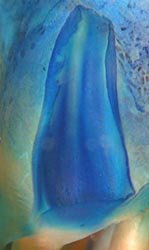
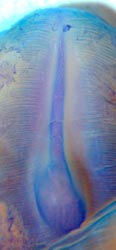
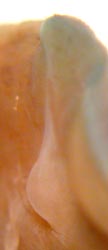
Figure. Funnel-mantle locking-apparatus of Mastigoteuthis sp. A, holotype, Equatorial Pacific. Left - Frontal view of funnel component. Middle - Frontal view of mantle component. Right - Side view of mantle component. Blue stain = methylene blue. Photographs by R. Young.
- Photophores
- Minute ("lens" diameter less than 0.1 mm) integumental photophores present but unrecognizable to naked eye due to small size and structure.
- Integumental photophores present on aboral surfaces of all arms, on dorsal and ventral surfaces of Head, mantle and fins, on ventral surface of funnel.
- Integumental photophores lie beneath the surface layer of chromatophores.
- Eyelid photophores absent.
 Click on an image to view larger version & data in a new window
Click on an image to view larger version & data in a new window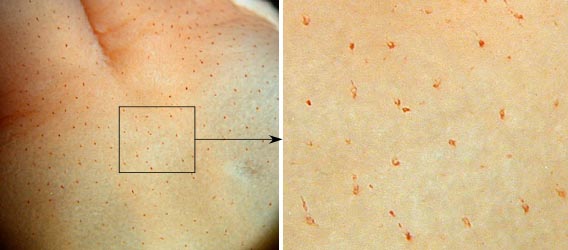
Figure. Ventral view of the head of Mastiogteuthis sp. A., holotype, Equatorial Pacific. Outer chromatophores were lost during capture leaving the scattered photophores visible. Enlargement at right allows photophores to be recognized by the presence of small, oval lenses. Photographs by R. Young.
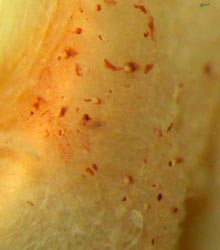
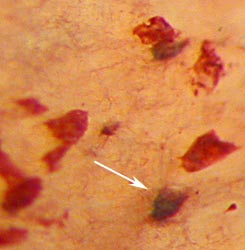
Figure. Photophores of Mastiogteuthis sp. A. Left - Anteriolateral view of the head near the eye opening looking at the lenses of the photophores. Right - High magnification of two photophores (one indicated by the arrow) and a few, lighter-red chromatophores that are more superficially located from a damaged region of the side of the head, 160 mm ML, Hawaiian waters.
Scanning electron micrographs of the arm and tentacle suckers can be seen here.
Comments
More details of the description can be seen here.
We identify structures here as photophores on the basis of a dark, pigmented "cup" and a spherical, whitish "lens" and their distribution as a separate layer beneath most chromatophores. No bioluminescence has been observed or attempted to be observed. Mastigoteuthis sp. A is unique among members of the M. magna-group in having photophores. If the surface chromatophore layer is intact, the deeper lying photophores can be difficult to recognize even under a microscope. Mastigoteuthis sp. A also differs from M. magna in the more elongate shape of the posterior bulb of the funnel locking-apparatus, dentition of the arm suckers and details of the beaks.
Molecular Characteristics
Mastigoteuthis sp. A is most closely related to M. magna based on morphological evidence (see the M. magna-group page). Molecular data indicate substantial divergence across the three genes examined (see Table below) and confirms that Mastigoteuthis sp. A is a separate species from M. magna. Hebert et al (2003) hypothesized a 2% rate of divergence in the COI locus as a general guideline for identifying distinct species, here the rate of divergence between M. microlucens and the morphologically similar M. magna was almost 10%. The more morphologically distinct M. hjorti had a COI sequence divergence rate 12% with Mastigoteuthis sp. A, only slightly greater than that of M. magna which further emphasizes the surprising result of 10% difference seen with M. magna (Young, Lindgren and Vecchione, submitted) (see also the Discussion of Phylogenetic Relationships on the Mastigoteuthis page).
| Locus | Base pairs | M. magna | M. hjorti | |
| Mastigoteuthis sp. A | COI rRNA | 658 | 9.89% | 11.7% |
| Mastigoteuthis sp. A | 16S rRNA | 528 | 3.40% | 6.02% |
| Mastigoteuthis sp. A | 12S rRNA | 404 | 5.13% | 7% |
More details on the squid that provided the molecular data can be found here.
Life History
At 5 mm ML Mastigoteuthis sp. A paralarvae are separated from similar-sized paralarvae of M. famelica, the only other common mastigoteuthid in Hawaiian waters, by the broader shape, larger eyes, more posterior digestive gland and tentacular suckers and chromatophores restricted to the distal end of the tentacle. At 7 mm ML the presence of anterior fin lobes also distinguishes Mastigoteuthis sp. A. At larger sizes, the slender shape, elongate fins and, by at least 17 mm ML, skin tubercules easily distinguish M. famelica. The differences between the two species diminish at sizes below 4.5 mm ML. The position of the digestive gland is useful to at least 3.5 mm ML. The smallest M. sp. A paralarva captured had a mantle length of 2.5 mm ML.

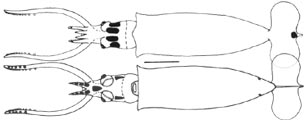
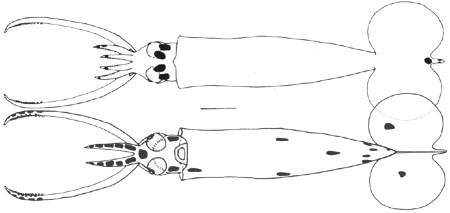
Figure. Ventral and dorsal views of Mastigoteuthis sp. A paralarvae, Hawaiian waters. Top - 4.6 mm ML. Bottom - 7.2 mm ML. Scale bars = 1 mm. Drawings from Young (1991) labeled as M. inermis.
Distribution
Geographical Distribution
Type locality: xxx. We have captured Mastigoteuthis sp. A in the region of the Hawaiian Archipelago to about ca. 26°N and south to the equator. This is the most common mastigoteuthid encountered in the region of the high (main) Hawaiian Islands.
Vertical Distribution
The vertical distribution of Mastigoteuthis sp. A in Hawaiian waters was examined by Young (1978). During the day most captures came from depths of 675-870 m; nighttime captures came from 255 to 725 m with most squid taken between 250 and 450 m.

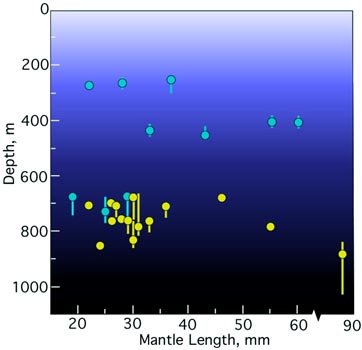
Figure. Vertical distribution chart of Mastigoteuthis sp. A. Captures were made with both open and opening/closing trawls. Bar - fishing depth-range of opening/closing trawl. Circle - Modal fishing depth for either trawl. Blue-filled circle - Night capture. Yellow-filled circle - Day capture. Note the breaks in the x-axis. Chart modified from Young (1978, labeled as M. inermis).
References
Hebert, P.D., S. Ratnasingham, and J.R. de Waard. 2003. Barcoding animal life: cytochrome c oxidase subunit I divergences among closely related species. Proc. R. Soc. Lond. B., 270: S96-S99
Young, R. E. 1978. Vertical distribution and photosensitive vesicles of pelagic cephalopods from Hawaiian waters. Fish. Bull., 76: 583-615.
Young, R. E. (1991). Chiroteuthid and related paralarvae from Hawaiian waters. Bull. Mar. Sci., 49: 162-185.
Young, R. E., A. Lindgren and M. Vecchione. Submitted. Mastigoteuthis xxx, a new species of the squid family Mastigoteuthidae (Mollusca: Cephalopoda). Proceedings of the Biological Society of Washington.
Title Illustrations

| Scientific Name | Mastigoteuthis sp. A |
|---|---|
| Location | Off Keahole Point, Hawaii Island |
| Creator | Michael Darden, photographer |
| Specimen Condition | Live Specimen |
| Sex | Female |
| Life Cycle Stage | Immature |
| View | Side |
| Size | 135 mm ML |
| Copyright | © West Hawaii Today |
About This Page
Richard E. Young

University of Hawaii, Honolulu, HI, USA

National Museum of Natural History, Washington, D. C. , USA

Ohio State University, Columbus, Ohio, USA
Page copyright © 2007 Richard E. Young, , and
All Rights Reserved.
- First online 19 November 2007
- Content changed 19 November 2007
Citing this page:
Young, Richard E., Vecchione, Michael, and Lindgren, Annie. 2007. Mastigoteuthis sp. A. Version 19 November 2007 (under construction). http://tolweb.org/Mastigoteuthis_sp._A/65304/2007.11.19 in The Tree of Life Web Project, http://tolweb.org/




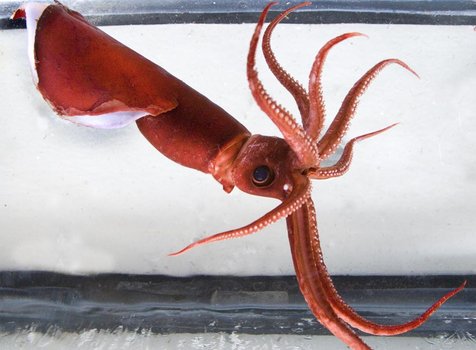
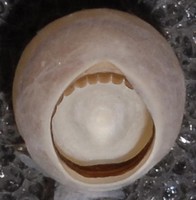
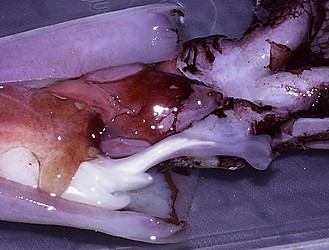



 Go to quick links
Go to quick search
Go to navigation for this section of the ToL site
Go to detailed links for the ToL site
Go to quick links
Go to quick search
Go to navigation for this section of the ToL site
Go to detailed links for the ToL site